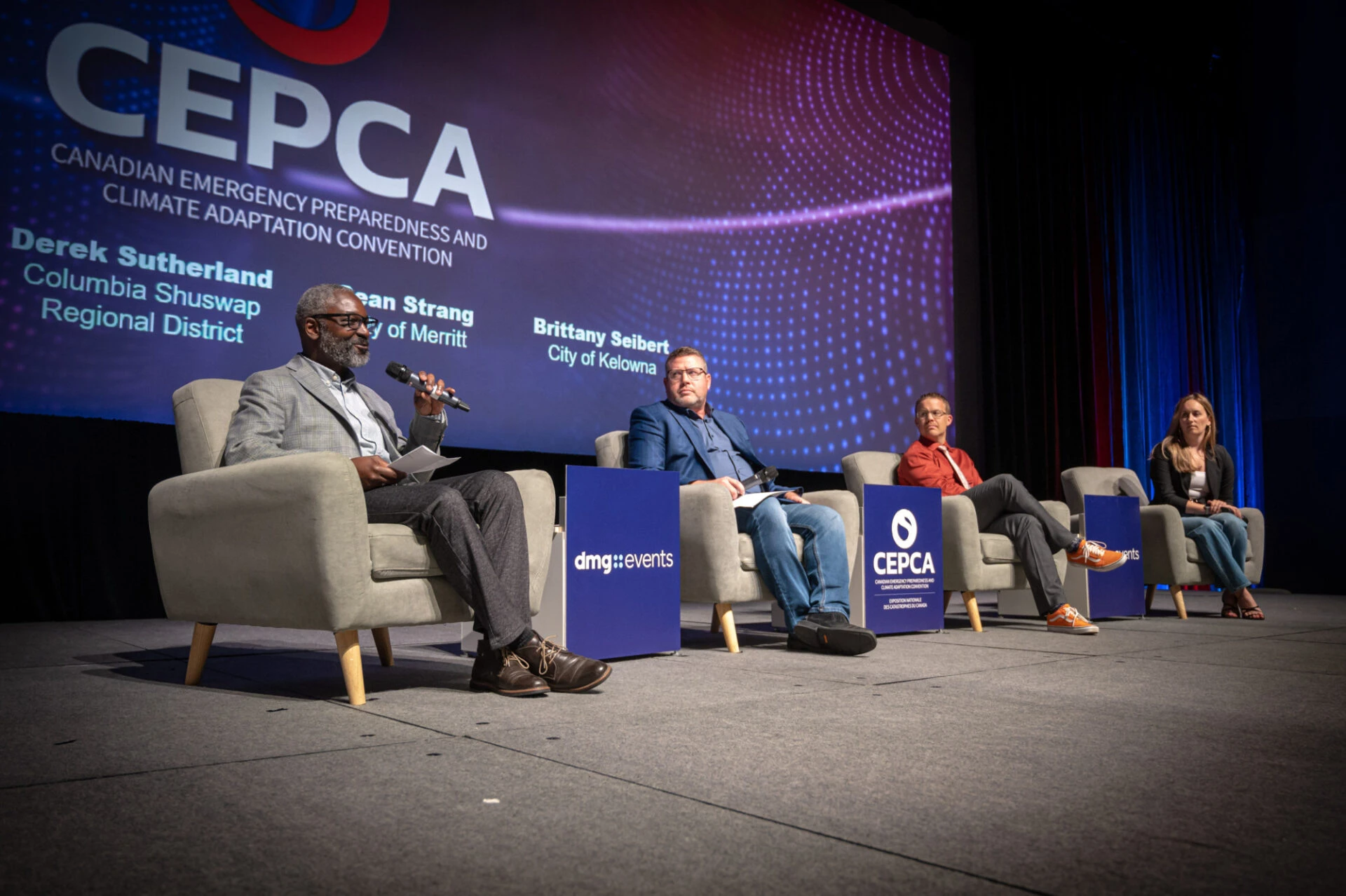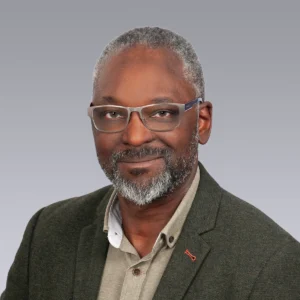The impacts of devastating wildfires in 2023 still linger across much of Canada. That wildfire season consumed seven times more forests than any other on record, destroying homes, businesses and communities nationwide. Those same communities are now grappling with the complexities of recovery — an effort that many were not fully equipped to manage. With climate change driving more frequent and severe weather, the need to strengthen our disaster-response capacity has never been more urgent.
At the recent Canadian Emergency Preparedness and Climate Adaptation Convention (CEPCA) in Ottawa, I had the opportunity to moderate a discussion focused on the critical recovery work currently underway. I was joined by panelists Derek Sutherland, General Manager of Community and Protective Services with the Columbia-Shuswap Regional District; Sean Strang, Director of Recovery and Mitigation with the City of Merritt; and Brittany Seibert, Regional Emergency Manager with the City of Kelowna, who shared their on-the-ground experiences.
We explored how communities like Merritt, Lytton, Abbotsford and the Columbia-Shuswap Regional District are rebuilding and pioneering recovery models that can help guide others facing future catastrophes. Establishing a ‘wraparound’ approach is central to all of these efforts, serving as much-needed holistic and collaborative framework that brings together community groups, recovery experts and all levels of government.
This discussion highlighted the real-world lessons learned over the past year and how communities across Canada are forging stronger, more resilient disaster response systems to address ongoing challenges. Here are a few of the topics we touched on during our discussion.
How can we introduce the wraparound approach to community recovery, planning and engagement?
Britney Seibert: There are two things we can do right now to shift the perspective of how we approach recovery. First, we need to stop thinking of recovery as a linear thing or as a separate silo from the other four pillars of emergency management. When you shift your perspective and start to think systematically, you become more adaptable and flexible. It allows you to see problems and complexities from a more holistic sense.
The second thing you can do is acknowledge lessons learned. Social capital really comes down to the networks and relationships we can lean into so we can work together to solve complex problems. One of the benefits of a regional program is having pre-established relationships. I know if I don’t have the answer to something, I have the connections and resources to call someone who does.
How can governments adapt governance structures to effectively support recovery efforts in the aftermath of the crisis?
Sean Strang: We’ve heard a lot about building community capacity throughout this conference, but I think there are many situations where we’re building too much community capacity and not enough centralized capacity.
To many, governance refers to who’s making the bylaws, legal documents, policies and procedures that guide emergency management. I think governance is really about who’s paying the bills – in our case, that’s the province. Senior levels of government should have the governance to look at where that money is going and how it’s being spent so they can help communities spend that money effectively.
We’re investing significant time, energy and capacity training communities to respond to a ‘black swan’ event, but I’m not sure that’s the most efficient use of resources going forward. You’re seeing huge grant streams and discussions around getting communities ready for level three Emergency Operations Centres (EOCs), but the people running those EOCs didn’t sign up to do emergency management. When we’re looking at the governance structure, we need to consider who’s making the decisions and having specialists from senior government agencies embedded in community EOC and Regional Operations Centre (ROC) governance structures.
Which strategies can we implement to ensure smooth coordination between community operation centres, coordinated responses and supporting participants involved in recovery?
Derek Sutherland: Early integration of recovery assets into the response is critically important. We learn about emergency management in pillars because it breaks it down into a format that’s easy to digest. If we apply that same format to how we use the pillars, emergency management doesn’t work – response becomes disconnected from recovery.
As soon as our EOC evacuates people, it starts planning how to get them back into their homes. Likewise, when we lose structures, we start the recovery planning process. In the case of the Brush Creek East fire, we lost several homes and structures, including our fire hall. Within the week, we had someone joining our EOC to write a re-entry and recovery plan so we could hand it to our recovery management team as soon as we transitioned out of response. This approach was incredibly helpful in shaping the recovery team’s mission for the community. However, I do think we could have clarified and communicated some of the response goals and objectives a little better as they bled into recovery objectives.
Over the past decade, we’ve put a lot of energy into developing community capacity. We now have about 56 neighbourhood emergency programs in the Shuswap region. These programs play an active role in disaster planning and enable communities to recover faster. I disagree with Sean a little bit that we shouldn’t invest more in community capacity, but I absolutely agree that we need capacity within the local authorities that are responding to these events.
What is an example of a specialized role that the community and organizational partnerships play to support individuals through the crisis to recovery transition?
Britney Seibert: When I was working for the City of Penticton, I had a really great relationship with our social development department. That relationship was born out of a smaller scale event that impacted a 25-unit apartment building. The individuals impacted were all uninsured, had complex needs and were at risk of potential homelessness.
In these types of situations, the province can only give 72 hours of support before potentially adding these 25 people to the streets. Our emergency supports team and I connected with my social development colleague so we could bring in different departments – whether it was within our own municipality, provincial organizations, or community NGOs – to say, “Here’s our need, who can help?” Within 24 hours, we put together a month’s worth of supports, ensuring these people had housing, food and clothing. It was pretty awesome to see.
We talk a lot about capacity, but when we start to break down the problem into pieces, all of a sudden it becomes a lot more manageable. It doesn’t necessarily mean that we’re going to be taking away a complete workload, but it is much easier to approach rather than assuming one organization or department is taking on the full brunt of the work.
When it comes to effective leadership and governance, what lessons can local leaders apply to future recovery events?
Sean Strang: One thing a lot of people don’t talk about is insurance. Some of the southern Alberta communities affected by the 2013 floods took a very strong stance on insurability for their residents. That’s not something the government normally does, but that’s something we need to be thinking about from an on the on the ground governance and policy perspective.
I can’t tell you how many people in my own community who could have gotten insurance. In Meritt we had less than 15 percent insurability for overland flooding. We’ve certainly seen other communities advocating for residents to significantly improve that ratio. So, think about all of the people and all of the resources that could be involved, but think about third-party insurance as well.
Another lesson I’ve learned is that when you have a full community-led governance model behind big recovery projects, there’s an added level of human interest, which is important from a connection standpoint. It’s also important to have outside experts or engineers. You need someone in a position of authority that you can point to and say, “They’re the expert and they’re the people who are recommending this.”
Why is it important to leverage funding for capacity support?
Derek Sutherland: Capacity becomes an issue very quickly, especially in a rural area like the Columbia-Shuswap Region, where we’re running lean operations. It’s common to assume that, if things go south, we can lean on our partners. But when we’re on fire, they’re on fire.
We need to make sure that we’re leveraging federal and provincial funding at the local level to make sure we’re adequately staffed. This past fire season, we didn’t bring in anyone to backfill for the secondment of our emergency program coordinator on the recovery team. This is where Michael Higgins and Colliers Project Leaders came in. They took a project management approach to recovery, which was really robust, but they still needed internal information from local authorities so they could liaise with them and do their work well. I encourage you all to backfill opportunities, get those bits of relief for your staff and get those resources in.
Building community resilience
Our CEPCA panel discussion highlighted the need to rethink how we approach community recovery and climate resilience. The panelists’ insights also reinforced the importance of building capacity by adopting a holistic, community-centered model, like the wraparound approach. This model encourages collaboration across all levels of government, including local organizations and industry experts to ensure recovery efforts are integrated and responsive to the unique needs of each community.
As we look to the future, one thing is clear: building resilience isn’t only about responding to an emergency, but creating systems that allow for adaptation, flexibility and sustainable recovery. With continued dedication to strengthening community capacity, leveraging external expertise and ensuring proper governance, communities across Canada will be better prepared for the challenges ahead.





